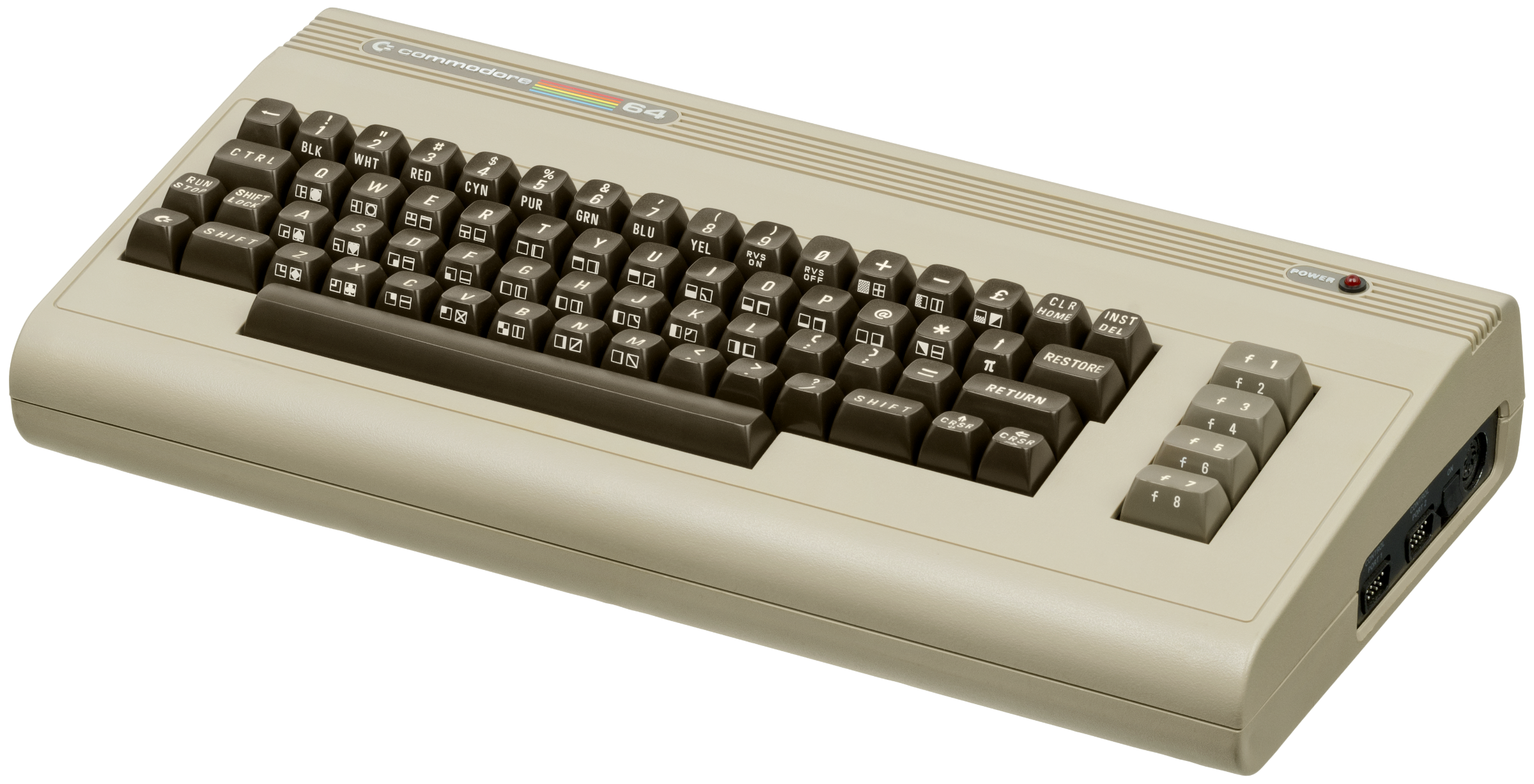Commodore 64
Being born in the UK in 1981, my articles about home computers are biased towards that time and place. This is due to both my own personal experience, and also a conscious attempt to provide an alternative UK bias to the predominant US bias amongst English-speaking people my age reminiscing about home computers.
C64 tech specs

Commodore 64 (Photo: Evan Amos)
Commodore 64 palette
- Released: 1982
- Company: Commodore
- Type: Home computer
- CPU: MOS 6510
- RAM: 64 KB
- Storage: Cassette tape, DD 5.25″ floppy disk (optional), 2DD 3.5″ floppy disk (optional)
- Display: 40×25 character / 320×200 pixel / 16 colours via CRT TV set
The Commodore 64 (C64 for short) was a home computer released by Commodore in 1982.
In the UK, its popularity was second only to the ZX Spectrum. The C64 was a far more capable machine, especially for games, but its price put it out of reach for many. If you were a child in the 1980s or 1990s, the chances were you knew someone with one of these two machines.
While Commodore's marketing department was apparently trying to convince people it was a serious office machine, its engineers were instead making it ideal for games. It sported an appealing colour palette (each colour was hand picked to look nice, rather than being mathematically equidistant from the others, as was the norm at the time),[1] sprites, and a sound chip that put many fully fledged synthesisers to shame — indeed, these engineers would later form Ensoniq in order to make professional samplers.
As with other home computers, while it had a large library of games, there was less serious software available.
For example, it had two professional German MIDI sequencers, SuperTrack and Pro-16, but even those were only used by a few professional musicians. It was the Atari ST with its built-in MIDI port that really got musicians into home computers as a serious alternative to dedicated hardware... with another pair of professional MIDI sequencers, by the same two German companies.
C64C
C64C tech specs
- Released: 1986
- Price: £159 (Night Moves / Mind Benders bundle)[2]
- Company: Commodore
- Type: Home computer
- CPU: MOS 6510
- RAM: 64 KB
- Storage: Cassette tape, DD 5.25″ floppy disk (optional), 2DD 3.5″ floppy disk (optional)
- Display: 40×25 character / 320×200 pixel via CRT TV set
The C64C was a thinner, beige version of the C64 released four years later.
On a sidenote, a year or two after the C64C was released, German supermarkets such as Aldi sold the C64G, which combined the larger "breadbin" shape of the original C64 with the beige colour of the C64C.
Night Moves / Mind Benders
Released in 1991, the £159 Night Moves / Mind Benders bundle included the C64 itself, the obligatory tape drive, two joysticks, and two compilations of games: Domark's Mind Benders included Confuzion, Snare, Split Personalities, and Trivial Pursuit; while Ocean's Night Moves included Midnight Resistance, Nightbreed, Shadow Warriors, and Sly Spy: Secret Agent.[2]
When they really wanted to sell off the last remaining stock, they threw in a third compilation, this time of utilities. Domark's Toolbox included The Image System, The Music System, The Shoot-'Em-Up Construction Kit, and Typing Tutor, along with an audiotape explaining the basics of what a computer was, and showing off the kind of music you could make on Commodore's next-generation Amiga.
On a personal note, this was the bundle my parents gave me when my Plus/4 eventually broke. It was ridiculously good value.
Accessories
Peripherals
- 1541 SS DD 5.25″ floppy disk drive (formats to 170 KB; can also use double-sided disks as 2 × 170 KB by simply manually turning the disk upside down)
- 1541-II SS DD 5.25″ floppy disk drive (ditto)
- 1571 DS DD 5.25″ floppy disk drive (formats to 360 KB)
- 1581 2DD 3.5″ floppy disk drive (formats to 800 KB)
Software
MIDI sequencers
- C-LAB SuperTrack
- Steinberg Pro-16
Technical notes
The C64's VIC-II chip was unique in letting the engineers pick an arbitrary 16 colours, rather than forcing them to be mathematically equidistant.[1]
References
- "Re: VIC-II colors" Robert "Bob" Yannes, Sep 1999
- "Argos spring/summer 1991 catalogue" Argos, 1991, p. 292
Commodore: Amiga | Commodore 64 | Plus/4
Home computers: Amiga | Beige box | Commodore 64 | PICO-8 | Plus/4 | ST | Soviet ZX Spectrum clones | ZX Spectrum | ZX Spectrum 128
Commodore 64: Pro-16


